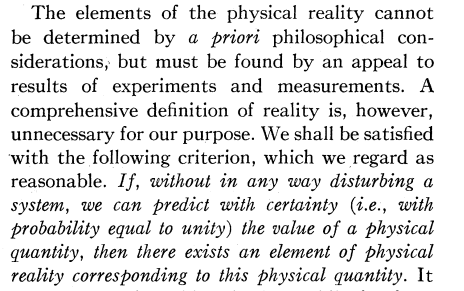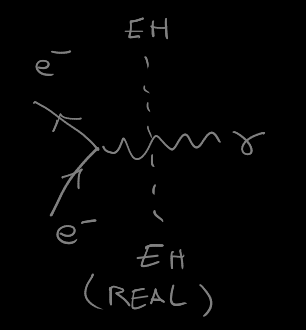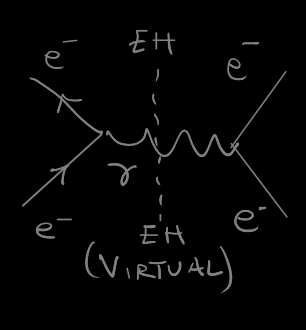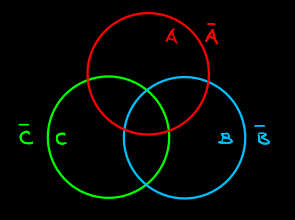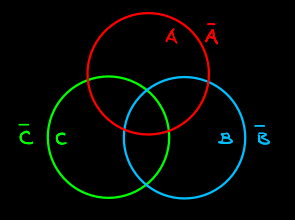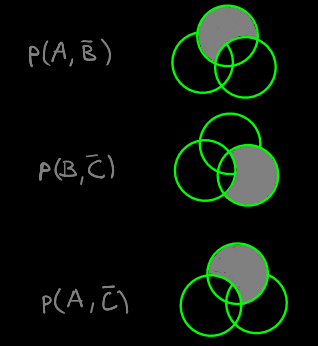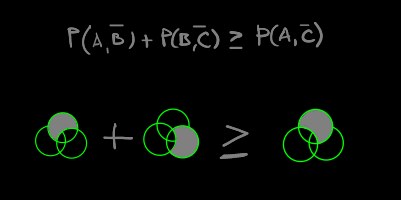-
Posts
4799 -
Joined
-
Days Won
55
Content Type
Profiles
Forums
Events
Everything posted by joigus
-
No, the inner dot product in the Hilbert space is not a fixed reference. It can change with time. It's the eigenstate that doesn't change. "Eigenstate" means "proper state" or "characteristic state" in German. It is a fundamental ingredient of quantum mechanics. Eigenvalues ("proper values" or "characteristic values") don't change either. Let alone "expand." The Higgs field has nothing to do with curvature. It's a quantum field defined on a flat space-time introduced to explain mass (rest energy) in the standard model of elementary particles. A field is more like an arrow rotating in an abstract space, and sitting on a geometric space. A quantum field is a similar thing, but jumps up and down between different levels that tell you the number of quanta. Einstein never knew anything about the Higgs field. Neither did Newton, of course, because both were dead when it was introduced. Field variables don't have curvature. They're not even "numeric" things. They're non-commuting things. Eigenstates don't fluctuate, though they are defined up to a global phase (a fixed complex number of length 1.) Eigenvalues are not conserved quantities in general. E (eigenvalue of the energy operator) corresponds to a conserved quantity in some contexts. X (eigenvalue of the x-position operator in quantum mechanics) never --repeat, never-- does. I'm sorry, but you're not making any sense in the context of standard physics.
-
Not even the froggiest idea, mate. But I will quote @TheVat:
-
Eigenstates are fixed references in the Hilbert space. They'd better not change... at all. I think you mean something else.
-
I can't make heads or tails of your diagram really. What's eigenstate expansion to you?
-
No. The singlet state is totally trivial under rotations. Rotations act on it trivially: they don't change it at all. That's why it looks like (up)x(down)-(down)(up) in any representation you choose. It does not code any orientation in it. The matrix that rotates it is the identity matrix. It is blind to rotations. I can try to rephrase this over and over... That's all I can do, I'm afraid.
-
Kind of... What Bohr argued was that the very nature of the measurement process somehow produces the results themselves, in such a way that the statistical constrictions on the outcomes and the measurement process itself were inseparable. Analysis of measurement in later decades clarified that even if you have filtering measurements, preparations... (no intervention with an interacting piece of equipment) quantum correlations are there. So they're not due to intervention during the measurement. The question of hidden variables really started with David Bohm (pro) and John Von Neumann (against). It was David Bohm who, to the best of my knowledge, started to work on "hidden variables", and Von Neumann who started thinking deeply about this problem, and formulated a first version of a theorem of impossibility. Then came Gleason with a theorem about the impossibility of assigning a binary function (true/false) which was continuous on the Bloch sphere, and from there, the last --more powerful for some-- version of that is the Kochen-Specker theorem. Bell's inequalities are a further refinement of an argument by Clauser, Horne, Shimony and Holt. There is another argument of impossibility by Greenberger, Horne and Zeilinger, that Mermin simplified, with just one observable. There is another argument by Conway and Kochen... To this day, there's so much literature about the subject that it's possible to spend a lifetime's worth of study learning it. As Swansont said: If you know some Pauli-matrix and angular momentum algebra, it's an interesting exercise to write down the singlet state and rotate it. People normally write it as |up, down> - |down, up> with a normalisation factor, and referred to the z direction. As if the z-direction played some kind of role in it. I doesn't. The states really are indeterminate. You can use any axis you want and it has the same form: |upx, downx> - |upx, downx> = |upy, downy>- |downy, upy> = |upn, downn>- |downn, upn> = etc. It's all a whole quantum state with like "no parts in it", "no internal arrows", so to speak. That's entanglement for you. Try it, it's very illuminating. The only thing that's physical is the whole vector. Then you obtain the expected value of spin along any direction you want and it always gives you zero for the sum. Then you do some further quantum mechanical calculations and consider the evolution operator from, say, t=0 (when the singlet is prepared and the particles are next to each other) and a time T when the particles have come apart, and you will see that no expected value depends on the fact that the spatial factor of the states has taken them apart. It's all in the maths of QM. As I said: The correlations are there when the singlet is prepared, they're there a minute later, they're there until you perform another measurement. And no experiment that I know of contradicts this. So yes, it's like the gloves in the sense that the correlations are initial. No superluminal action at a distance. Period.
-
No problem. Part of the reason why this is all very confusing is because so much nonsense has been spread for so long that we think these theorems, as well as the experiments, say what they actually don't. The abstract nature of quantum mechanics makes it quite difficult --if not impossible-- to get any intuitive picture of the part of it that's really bizarre. So we forget that another part of it is just propagation of waves.
-
If the EP breaks down, then we no longer have GR. If so, why bother with Schwarzschild solution? It would be misguiding us all along. Sound, as well as strong forces, do not exist in that region of space, because it's a vacuum solution. And yes, tidal forces are important, they're coded in the connection coefficients, and they become the more relevant the farther away you get from the point you choose to expand your metric. The Doppler effect is like the "time-component" of these tidal forces, so to speak. It's coded in the \( \Gamma^{0}_{00} \) of the connection. You can obtain this from the geodesic equation. And sure enough, the observer would notice something funny going on with all kinds of optical effects. What he wouldn't notice is any ficticious forces due to acceleration --provided the horizon is big enough in comparison with his own size. Generally, the 0-component terms are far more noticeable because of the large value of the speed of light. It's quite an exercise of imagination to picture how an observer might experience such a voyage, but certainly I would expect all kinds of strange optical phenomena. Mirrors not reflecting properly probably being one of them.
-
You do sound like a bot, but thanks for the clarification. How can two incompatible notions of space be both correct? What appearance? What does a Hilbert space look like? And a Higgs field? Space-time is a background, while the Hilbert space of a particle is the space of all possible states of that particle that take values on that background. How could they be indistinguishable? They're very different things. No. A Hilbert space does not expand. It had better not, as you get probabilities from it. Neither does the Higgs field. It had better not, for good reasons too. Why do you say these things (and more) that don't make any sense? I'm sorry for trying to test your human nature, but you made very loose connections, and sounded to me like a bot. Also, personal opinions don't play any role in mainstream science.
-
OK. I know where the trouble is. Yes, Bob could in principle determine whether a measurement has been performed. Mind you, I say "in principle." Whether there is any viable way to do that is another matter. But this change in the state is subject to propagation as the interaction it actually is, and is therefore subject to delay, as any other actual interaction. IOW, if you really "touch" the system, the influence will propagate causally. But Bob would learn about it no sooner than d/c, where d is the distance between him and Alice in their inertial system. I didn't say Bob would know it instantly. This makes sense, doesn't it? Don't forget that Einstein's criterion for what an "element of reality is" means: (from the famous EPR paper that gave rise to the whole debate: https://cds.cern.ch/record/405662/files/PhysRev.47.777.pdf) Now, what's troubling you, I think, is that we've heard these terms "non-locality", "superluminal action at a distance", "spooky" this or that, that we can't help but think that every time information is obtained from a quantum system, the question of non-locality is at stake. This is not the case when coherence loss is the issue. Without realising it, you're assuming this influence must be superluminal, or instantaneous. Why? It doesn't. It's an actual interaction! Pay attention to the words "without in any way disturbing a system" in EPR's paper, because they're essential. The verification that somebody has performed a measurement on the other particle would propagate at a finite speed, because the observable, if you will, "whether someone has performed a measurement" does involve an interaction. So it is not what Einstein called an element of reality. It is only on those elements of reality (values of which information can be obtained without in any way disturbing the system) that the question is, at least, at stake. This part is a bit more technical: The evidence of that interaction would be reflected in what we call the density matrix, which essentially consists of statistical weights: the probabilities 1/2, 1/2 that I mentioned before (and constitute the diagonal elements of the density matrix: those would not change) plus the relative phases between the states "up" and "down" (which constitute the non-diagonal elements: those would change). But those coherences are a part of the wave function that is affected by the interaction, and they would take some time to reach Bob. Nevertheless, after enough time has passed, Bob would be able to tell (in principle, I repeat) that someone's been messing with the state. Nothing more. In fact, he wouldn't be able to tell whether it was Alice, or a gust of wind, or what the output of the experiment was unless he measured the same projection of spin they agreed to measure. --- (end of the more technical comments). The point is perhaps subtle. But the take-home lesson is: Not every time a leaf falls to the ground is locality at stake.
-
That sounds right. I wasn't very assertive about it, though: How do you devise such an interference experiment? I was thinking about this for a while, and couldn't come up with any way to do that. The question boils down to: How do you know a beam of particles that give you random spin projections is in a pure state or a mixture state? On second thought, I don't think you can, unless you gather information of all the parts. But then the superluminal character is no longer an issue. Yes. Thank you for pointing that out. We almost x-posted. I would like to think about that a bit longer...
-
1) 重點是什麼? 2) Who died cuatro days ago? You answer those two, then we talk about the universe. Sorry for turning all Voight-Kampff on you. Indulge me.
-
Then you absolutely have missed the point of what's going on, and are still living in the confusion. This is what Murray Gell-Mann calls the "widespread foolishness associated with the EPR effect." Go back to the example of the gloves that MigL was talking about. One glove goes to Australia and the other stays with me. I open the box and find out that it's LH. I thereby know immediately that hoola got the RH one. Would you think for a moment that one glove corresponds to the right hand and the other to the left hand because some "spooky action at a distance" has taken place between them? That's what's foolish to say. The gloves are perfectly anti-correlated just because the correlation was there from the beginning. I can repeat the point over and over if you wish, but I can't make it any more clear. The story of the argument is somewhat contorted, because Einstein thought of a different example, with position and momentum, and then David Bohm proposed one with spins. But you got the story wrong too. That's for another post, though.
-
thanx
-
You're confusing correlations between observables being there (and actually not changing at all during evolution) with observables being indeterminate. It's not the same thing. In the singlet state, correlations are very well defined, yet the projection of spin along any direction is expected to be zero on average. I said it before. It's about a couple of variables having zero expected value for each one of them, and yet being perfectly defined and with zero dispersion (no statistical variance, standard deviation, dispersion, as physicists say) for the sum of both. Schematically, if A and B are the respective projections of spin along a fixed axis for both particles respectively, Average values of both: \[ \left\langle A\right\rangle =0=\left\langle B\right\rangle \] Average value of the sum: \[ \left\langle A+B\right\rangle =0 \] Dispersion of each: \[ \sqrt{\left\langle A^{2}\right\rangle -\left\langle A\right\rangle ^{2}}=\sqrt{\left\langle A^{2}\right\rangle }=\sqrt{\frac{1}{4}}=\frac{1}{2} \] But, (and here's the rub) dispersion of the sum of both: \[ \sqrt{\left\langle A^{2}+2AB+B^{2}\right\rangle }=\sqrt{\frac{1}{4}+2\frac{-1}{4}+\frac{1}{4}}=0 \] So, as I said earlier, each one of them is as indeterminate as it can be, but the quantity formed by the addition of both is sure zero every single time we measure. Does that clarify the discussion? Sorry, I wasn't clear here. It's about a couple of variables (which have zero expected value for each one of them) having big dispersion for each one of them, while being dispersionless (zero dispersion) for the sum of both. Dispersion is a measure of how "statistically spread" the results are.
-
Yes. It's a physical constant altogether, and let's see what it's equal to: \[ R_{S}=\frac{2M_{BH}G}{c^{2}} \] \[ \frac{M_{BH}}{R_{S}}=\frac{M_{BH}}{2M_{BH}G/c^{2}}=\frac{c^{2}}{2G} \] It's a universal constant just because it's the quotient of two universal constants. It happens to have the dimensions of a linear density. That doesn't mean anything in itself. Tidal effects begin to be important long before you reach Planck's scale. Planck's scale is more about quantum effects. The h-bar is giving it away, isn't it?
-
Of course, because in natural units (G=1, c=1) M = RSchwarzschild. In natural units M/RSchwarzschild = 1 (I think I'm off by a factor of 2. Little wonder it always gives you the same thing. There's nothing mysterious about it. Well, not everything would be completely normal. The equivalence principle (EP) does tell you that the laws of physics are locally the same. Placing things at some distance and expecting they're gonna work the same is not whe the EP tells you. Perhaps mirrors ceasing to work as mirrors is another kind of tidal effect. Suppose you have very long arms, and extend them while you're crossing the event horizon. I would expect tidal forces to start manifesting themselves at some point. So not everything is the same.
-
You're on the right track. You may be just a sign/and a power off? I don't have the time to check it now, but you got the main 2 ideas for solving it. Yes, please don't spoil the fun in case people want to give it a try. It's not a standard derivation technique because the function is so weird, but I'm sure someone's solved it somewhere else.
-
x * (x-pi) * (x + pi) * ( x-2pi) * (x + 2pi) * ( x - 3pi ) * (x + 3pi) ..... (x - n pi) * ( x + n pi)... seems a non-convergent sequence. I wouldn't dare to touch this with a barge pole. But if I were in the mood of playing "being Euler", I would try to group (x-kpi)(x+kpi)=x²-k²pi² for integer k (not guaranteed to work, as reordering of infinite divergent sequences is dicy at best), take natural logs (to have sums instead of products) and work in the complex plane to see if I can "regularise" it somehow. For example, it seems more sensible to me would be to introduce (guess at) some regularizing quotiens from the get-go. ... Funny, I was thinking "this reminds me of something I've seen before" when I've come across this: https://math.stackexchange.com/questions/674769/sinx-infinite-product-formula-how-did-euler-prove-it But it's not just one m that you need. Every single factor needs a different m. Those would be the "regularising quotients" I suggested.
-
I'm not sure what you mean here. The linear density? I'm not familiar with the concept of temporal density either. I'm having problems understanding "the interface between them (BH's?) and the universe." I'm not saying it's meaningless; I'm saying I don't know what it means. I think I understand what you mean here. This is similar to questions about how a man sees his own body as he crosses the horizon -if he enters feet first, he wouldn't be able to see his own feet. My best guess is that he would see the mirror as a shape obstructing the light from behind, but not reflecting his own image. So it wouldn't be able to work as a mirror for him. But again, for all he knows, the space around him would "feel" quite normal if the BH is big enough that tidal forces are negligible.
-
Seems like you're suggesting a random-number generator, not exactly an algorithm... That's precisely when you get into trouble with locality. Don't you see? These "random-number generators" should agree to produce perfectly correlated random numbers at Alice's and Bob's position when asked the same question, and totally uncorrelated random numbers when asked different questions.
-

Some questions on Blackholes
joigus replied to AbstractDreamer's topic in Modern and Theoretical Physics
This is because electromagnetic radiation is very different from an electrostatic field. Likewise, gravitons, and also gravitational waves, are very different from a gravitational field. Quantum field theory gives you a picture of this. Can't happen. Can happen. Virtual particles can do... well, practically anything they want. In QFT lingo, virtual particles go as far as they want to go in the phase space. They can have mass, they can go faster than light, etc. As long as they disappear well within the domain of Heisenberg's uncertainty principle. It's only external legs in Feynman diagrams that must behave. https://physics.stackexchange.com/questions/937/how-does-gravity-escape-a-black-hole Very good question, by the way. -
It is correct to describe classical gloves, the gloves we are familiar with. Exactly. It's not a property of ordinary gloves to be in a state that's neither left-handed, nor right-handed, but in a quantum superposition of both. That's what ordinary gloves can't do. A system that did this --hypothetically or actually--, as you well know, is called a Schrödinger cat. People call Schrödinger cats other kind of systems that are macroscopic, but keep quantum coherence. But I think there's a slight shift in meaning there, because ordinary cats (which are always either dead or alive) don't keep quantum coherence. Exactly. That was Bell's point in is paper Bertlemann's Sockets and the Nature of Reality. The point being: You don't need information transfer at a distance in order to have perfect distant correlations. You only need to prepare the system with those correlations built in. In what sense are you using the word "box"? In science people talk about a black box when there's some internal mechanism we can't see, or we don't care about, except for its input/output workings. You could call the evolution of the wave function a "black box" if you want. It all depends on what you mean by a "black box". When I said: what I meant is: You can't reproduce quantum behaviour by means of any classical and local internal switches, so to speak, that do the trick. For example, MigL's gloves is a perfect example that illustrates that there doesn't have to be anything funny (non-local, superluminal) going on with one classical observable (handedness of a glove) and a pair of classical (non-quantum) systems (the gloves). John Bell provided a similar example that he called "Bertlemann's socks": One is pink, the other is green, or so I remember. What it illustrates is that perfect anti-correlation, or correlation between two distant things is not the problem. The problem with quantum systems is evidenced when you consider at least 3 observables. And not just any observables; you have to pick them cleverly. Otherwise, you fall back to a range of variables where the classical explanation could work. So let's make a pair of "quantum gloves." Handedness: When one is R-handed, the other is L-handed Colour: When one is B (black) the other is W (white) Material: When one is N (nylon) the other is F (felt) Whenever you take a look, the gloves are either RH or LH, either B or W, either N or F. But you're only allowed to take a look at any one of these properties at a time. All of this happens only upon observation. If the system's not being observed, the quantum state allows you to be in so-called superposition states, in which the system is neither totally RH, nor totally LH, etc. ---------------------- Bell's Theorem Bell's theorem is a very simple constriction on the probabilities of three independent assertions that are subject to classical logic (at all times, they're either true or not true.) A: Possible outcomes: A is true | A is not true B: Possible outcomes: B is true | B is not true 😄 Possible outcomes: C is true | C is not true We can represent these outcomes as A, and A with a bar on top, etc. Like this: The probability of A being true is the interior of the red circle. A not being true is the exterior. Etc. Now, it's pretty clear (in images) that, p(A,B-bar) being "probability of A being true and B being not true, etc., and, next to obvious* that, This is what, quite "simply" quantum mechanics doesn't obey. There is this interesting case: A = "the x projection of the particle's spin is up" (not A, or A-bar is read by substituting "is up" for "is down", etc. B = "the y projection of the particle's spin is up", etc. C = "the projection of the particle's spin along a direction 45º with respect to both x and y is up". Then you use some so-called sigma-matrix algebra and voilá, Bell's theorem is violated. Experiments, BTW, confirm this within detector-noise tolerances. It's been checked upwards and backwards. What's wrong? Nothing's wrong. It's simply not true that propositions A, B, and C all have a definite answer, true or not true while the system is evolving. It's all withing the very simple, transparent box of quantum mechanics. The tricky thing is "what happens to the quantum vectors when I perform a measurement?" But that's another story. *Actually, not that obvious from the picture. I have a better proof elsewhere.
-
The black box is in the mathematics of quantum mechanics. A particle can give you binary (up or down) projections of spin along any direction in a continuum of possible directions. So you would think, aha! the spin must be lying along some of these directions pointing in a certain way (up or down). If you assume this kind of classical logic, as Gell-Mann says, you're gonna have to conclude that there are negative probabilities, or instantaneous communication (non-locality), or both. None of that happens. What happens is quantum mechanics. Bell's theorem is a proof that whenever you have 3 propositions that are either true or not true (classical logic), eg: A, not A B, not B C, not C then the probabilities satisfy the following constraint: probability(A,not B)+probability(B,not C) is greater or equal to probability(A,not C) Bell found a set of propositions that violate this constraint according to quantum mechanics. So it's not that anything travels faster than light. It's just that it's simply not true that some propositions are either true or false. This condition, if you will, "that something that could be true (has non-zero probability of happening) has become true" cannot be made into a signal. Think how delicately all depends on the results being actually random: If Alice could decide what the outcome is going to be, her sequence of up, down, up, up, etc. would be read by Bob as the negative image of the message: down, up, down, down, etc.
-
Very fine point, but I think you're right. He may be able to devise a clever interference experiment though, to determine that someone's been messing with the state, because coherence has been broken. So he could determine in principle that Alice has performed a measurement, but he wouldn't be able to tell which outcome Alice got until he made the measurement.


